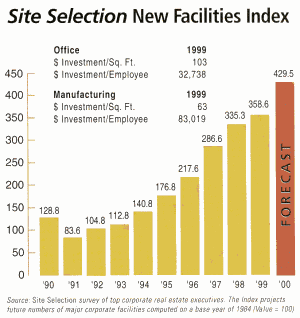Y2OK: SSI Projects Bullish 20 Percent Expansion
b y J A C K L Y N E
Features
Y2OK: SSI Projects Bullish 20 Percent Expansion
b y J A C K L Y N E
We have survived Y2K, the millennial-turning Chicken Little equivalent of Comet Kahoutek’s similarly fizzling hysteria in the 1970s. So, since there’s going to be a future, what does it hold in 2000 for corporate expansion?
2000 looks Y2OK, according to the Site Selection Index (SSI), which projects 20 percent worldwide growth in new corporate facility and expansion activity.
The Index is based on two important inputs: First, there’s SS‘s annual survey of expansion plans at some of the most active global real estate players. Secondly, there’s the New Plant database, the SSI’s backbone and the data repository through which SS has systematically tracked, tallied and analyzed corporate expansion activity for 30-plus years.
Combining that history with future expansion plans yields some rather accurate projections, it seems: The SSI, in fact, has correctly anticipated facility growth trends since its 1991 inception (see chart).
1999’s Dim Bulb Brightens
While that Index explanation is obviously necessary, it also obviously evokes a line from Shakespeare: “My pride fell with my fortunes.”
Well, yes. And, frankly, last year we were sweating bullets, eyeing a light at the end of the tunnel that suspiciously resembled an onrushing train. For 1999, you see, the SSI projected a 15 percent expansion increase. Simultaneously, many business gurus were forecasting a Y2Kahoutek-like economy.
But the SSI again correctly projected the trend, although ’99 global expansion activity rose by a more modest 7 percent — hardly surprising, since the Asian economic contagion ultimately drove one-third of the world into recession.
Strong Global Vital Signs
2000’s substantial 20 percent growth projection, then, looks far less daunting, particularly given a business expansion climate that, ostensibly, is far more favorable.
The International Monetary Fund (IMF), for example, predicts a 3.4 percent global economic expansion in 2000, which would mark a striking 48 percent increase over 1999. “As emerging market economies’ adjustments run their course, global economic growth should pick up,” says Stanley Fischer, IMF first deputy managing director.
But the IMF’s rosy 2000 projection, notes Fischer, depends on “achieving a soft landing for the U.S., with growth slowing to keep inflation pressures at bay.” Clear signs of recovery from Japan, rocked by its worst recession in 50 years, are also an essential for world economic health in 2000, the IMF stresses.
But John Bralower, president of real estate investment bankers Sonnenblick-Goldman, says recovery signs are already sufficiently strong that “Asia will increasingly be a target for American investment in 2000.”

Signs are also encouraging from Europe, once considered the world’s economic weak sister. The European Commission (EC) predicts that European Union economic growth in both 2000 and 2001 will reach 3 percent, a 43 percent increase from 1999, while inflation will stay below 2 percent. But that growth depends on the Euro’s sustained strength, the EC cautions.
Finally, the world economy as a whole continues to enjoy the combination that’s been the catalyst for the long-term facility expansion upsurge: low inflation, strong consumer confidence and free trade sentiments, and an absence of major wars. “Peace times,” explains Deutsche Bank Securities Chief Economist Edward Yardeni, “tend to have a deflationary impact due to global competition, which depresses profits, demanding constant innovation.”
Y2K, though, will still likely affect 2000’s expansion pace. Y2K fears spurred a substantial number of firms’ late-1999 inventory stockpiling. Solectron, for example, reportedly upped inventory by 30 percent.
How fast such firms return to normal, expansion-minded operations will depend on the speed of their logistics systems, say analysts, with players with long supply chains rebounding most slowly. And that will likely significantly dampen facility expansion, at least in the early months of Y2OK.
SS